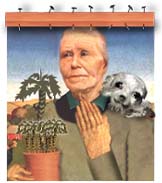|

The mystical
virtues and powers of numbers were a favorite subject of speculation in the
ancient world. In the Sefer Yezirah[1]
and the later medieval Kabbalah this theme came in for a great deal of elaboration.
But long before Pythagorean philosophy and Kabbalistic theosophy exalted the
conception into systems of thought, the common man had recognized the occult
potency of numbers by according them an honored place in his superstitions.
Medieval charms and magical recipes reflect this universal attitude. Just as
the recurrent blows of a sledge-hammer drive a wedge inexorably into a recalcitrant
block of wood, so repetition of an incantation enhances its force, by making
it so much more difficult for the spirits to escape its compulsion....
"All
sevens are beloved," says the Midrash, and we may well accept its
verdict when we recall the manifold sacred associations of that numeral
in Judaism. In magic the seven was second only to the three in popularity.
Time and time again the instructions run: repeat seven times, draw seven
circles on the ground, do this daily for seven days, etc. But what I imagine
may be accepted as the classic illustration of the number seven in magic
is this Talmudic prescription to cure a tertian fever:
"Take seven
prickles from seven palm trees, seven chips from seven beams, seven
nails from seven bridges, seven ashes from seven ovens, seven scoops
of earth from seven door sockets, seven pieces of pitch from seven ships,
seven handfuls of cumin, and seven hairs from the beard of an old dog,
and tie them to the neck-hole of the shirt with a white twisted cord."[2]
Extravagant
as medieval magic often was, it cannot duplicate such an outbreak of sevens
in one recipe.
[Somewhat less extravagant
but likewise impressive is one of the remedies suggested for a quotidian
fever: "Let him take a pitcherful of water to the river and say,
‘River, river! Lend me a pitcherful of water for the journey I
have to make.' He then waves it seven times around his head, throws
the water behind him and exclaims, ‘River, river! I take back the
water which you gave me, because the journey I had to make has gone
and returned the same day.'"[3]
The circle is another
ancient and universal magical symbol. The invocation of demons is a
dangerous business, and the magician must take steps to protect himself
in the event that his spirit adjutants get out of hand. What simpler
or more obvious device than to exclude them from his immediate environment?
The widespread custom of circle drawing was often combined with the
magical use of the number seven.
In this connection
it is interesting that in the Orient the general practice at a funeral
is for the mourners actually to encircle the coffin seven times, reciting
the "anti-demonic psalm." Similarly the late custom among
East-European Jews (which also prevails in the Orient) for the bride
to walk around her groom under the wedding canopy three, or seven times,
was probably originally intended to keep off the demons who were waiting
to pounce upon them. The magician's circle was usually inscribed with
a sword or knife, and sometimes the directions require three, or seven
concentric circles, the metal and the number adding to the protective
virtues of this device.[4]
|
[1]
a 3rd-4th c. Hebrew teatise on cosmogony and cosmology, and
one of the most influential works of Jewish science, philosophy
and (because of the kabbalistic commentaries written on it)
mysticism. [back]
|
|
 From :
Jewish Magic and Superstition: A Study in Folk Religion, by
Joshua Trachtenberg (Jewish Publication Society, 1973).
|
SEVEN Table of Contents
|